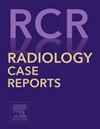Dural Arteriovenous Fistula with Bilateral Agenesia of Intracranial Venous Sinuses: A Case Report
Q4 Medicine
引用次数: 0
Abstract
A 27-year-old male patient presented with a history of long-standing headaches, progressive head circumference growth, and a ventriculoperitoneal shunt valve placement in 2018. He was referred for consultation and underwent endovascular neurosurgery in 2019 due to MRI findings suggestive of a cerebral arteriovenous malformation. A neurosurgical board was convened to discuss findings from cerebral panangiography and endovascular treatment options. Cerebral panangiography revealed a Cognard type IV dural arteriovenous fistula, leading to the recommendation of endovascular treatment with Phil embolizing liquid material and a triaxial balloon to reduce venous hypertension. Catheterization was performed through a posterior branch of the right meningeal artery directly afferent to the fistula. A second intervention was performed 6 months later, again utilizing endovascular therapy with Phil embolizing liquid material and balloon via the right femoral artery. The intervention revealed a remnant of the dural arteriovenous fistula with a venous aneurysm in the right sinus. Over a period of several years, 3 additional interventions were performed at intervals of approximately 7 months, achieving partial occlusion. During the fifth intervention, the patient exhibited neurological deterioration, prompting further imaging studies to assess thrombosis of the longitudinal sinus. Endovascular treatment with embolizing liquid material and corticosteroid therapy was administered.
硬脑膜动静脉瘘伴双侧颅内静脉窦缺失1例
一名27岁男性患者于2018年出现长期头痛病史,头围进行性增长,并植入脑室-腹膜分流阀。由于MRI结果提示脑动静脉畸形,他于2019年接受了血管内神经外科手术。召开了一个神经外科委员会,讨论脑血管造影的发现和血管内治疗方案。脑血管造影显示一个Cognard型IV型硬脑膜动静脉瘘,因此建议使用Phil栓塞液体材料和三轴球囊进行血管内治疗以降低静脉高压。导管置入通过右脑膜动脉后支直接传入瘘管。6个月后进行了第二次干预,再次使用经右股动脉的Phil栓塞液体材料和球囊进行血管内治疗。干预显示残余的硬脑膜动静脉瘘与右窦静脉动脉瘤。在几年的时间里,每隔大约7个月进行3次额外的干预,达到部分闭塞。在第五次干预期间,患者表现出神经功能恶化,促使进一步影像学检查以评估纵窦血栓形成。给予血管内栓塞液体材料和皮质类固醇治疗。
本文章由计算机程序翻译,如有差异,请以英文原文为准。
求助全文
约1分钟内获得全文
求助全文
来源期刊

Radiology Case Reports
Medicine-Radiology, Nuclear Medicine and Imaging
CiteScore
1.10
自引率
0.00%
发文量
1074
审稿时长
30 days
期刊介绍:
The content of this journal is exclusively case reports that feature diagnostic imaging. Categories in which case reports can be placed include the musculoskeletal system, spine, central nervous system, head and neck, cardiovascular, chest, gastrointestinal, genitourinary, multisystem, pediatric, emergency, women''s imaging, oncologic, normal variants, medical devices, foreign bodies, interventional radiology, nuclear medicine, molecular imaging, ultrasonography, imaging artifacts, forensic, anthropological, and medical-legal. Articles must be well-documented and include a review of the appropriate literature.
 求助内容:
求助内容: 应助结果提醒方式:
应助结果提醒方式:


